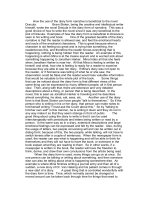How make use of photoshop CS6
Bạn đang xem bản rút gọn của tài liệu. Xem và tải ngay bản đầy đủ của tài liệu tại đây (5.13 MB, 49 trang )
What's New In Photoshop CS6: Your
Ultimate Overview
By TrueKolor />Edited by Justin Pot
This manual is the intellectual property of MakeUseOf. It must only be published in its
original form. Using parts or republishing altered parts of this guide is prohibited without
permission from MakeUseOf.com
Think you’ve got what it takes to write a manual for MakeUseOf.com? We’re always willing
to hear a pitch! Send your ideas to ; you might earn up to $400.
Table Of Contents
1. Introduction
2. Tips and Tricks
3. Tweaking Images
4. Speed Up Photoshop CS6’s Performance
5. Conclusion
MakeUseOf
1. Introduction
Even if you have never used Adobe Photoshop before, I am pretty sure you’ve heard about
it. The software is so iconic it’s become a verb: to “Photoshop” a photo means to edit it in a
way that bends reality.
Once you get your hands on Photoshop you become an owner of a fantastically powerful
image editing tool. And this is why we are writing these guides – to help make your
Photoshop experience easier and comfy. We have already covered a lot of tools, tips and
tricks of Photoshop CS5 in our previous guides (Part I, II, III and IV), so I thought people
would have had enough of Photoshop manuals by now. But then CS6 came out.
Compared to earlier updates, CS6 is huge – I would even say revolutionary. This update
brought many improvements to the interface and performance. There are also more “magic”
tools, which enhance the entire workflow a lot, making our lives much easier. So, it is now
obvious that these guys at Adobe really check users’ feedback and wishes. Hands down.
In this guide, I will introduce you to the new features of Photoshop CS6 and show you what
they are and how to use them.
Please note, that I am using Windows, so Mac users will have to use slightly different key
combinations (like the Command key instead of Ctrl, and Option instead of Alt).
Ok. Let’s see what’s new! We’ll start with some tips and tricks.
2. Tips and Tricks
2.1. Quickly Change the Appearance of Photoshop CS6
New appearance is the first thing that surprises a Photoshop user. If you have any
experience in older Photoshop versions, you will see what I mean – the interface is dark
now. This, in my opinion, makes you feel more comfortable and helps you concentrate on
your image:
If you want to change the color scheme, use Shift+F2 (Mac: Shift+Fn+F2) to make it lighter
and Shift+F1 (Mac: Shift+Fn+F1) to make it darker. There are 4 tones of grey to choose
from:
Now, choose your favorite styling and let’s proceed.
2.2. Background Save and Autorecovery
Remember the last time you were working on some project and all of a sudden Photoshop
crashed? I am sure you do – it’s always devastating. With CS6, you don’t have to worry
about losing all your efforts and hard work in the case of a crash – when you reopen
Photoshop it will recover the files you were working on.
The new saving feature works on background and can be configured at Edit->Preferences-
>File Handling:
2.3. New Layer Features
Photoshop CS6 comes with some awesome improvements on Layers as well. Now you can
filter them by an attribute, search by name, apply blend mode to multiple layers, and even
more.
Let’s go through some of those features one by one.
2.3.1. Filtering
When working on a complex project in Photoshop we always end up with a pile of layers.
Focused more on the creative side of the work, I actually forget to name those layers and
end up with something like Layer 46, Layer 89, etc. Sound familiar? Then you will like this
new feature.
You can quickly find layers by their Kind (Pixel layers, Adjustment layers, Type layers,
Shape layers or Smart objects), Name (write a layers name), Effect (Blending options),
Mode, Attribute and by Color:
Here’s a reference table I’ve prepared for you:
2.3.2. Show Transform Controls
This feature is a little one but I am sure many of you will find it handy. Now you don’t have
to use Ctrl+T to show Transform Controls for a selected object or a layer every time. You
can tell Photoshop to automatically show them for you – just check that option on Move (V)
tool’s options panel:
2.3.3. Assigning Blend Modes to Multiple Layers or Groups
In CS6 you can apply a blend mode to multiple layers and/or groups. Just select the
desired layers and/or groups and choose a blend mode as usual. Let’s see how it works.
I’ve selected a layer with a smart object and a group of text layers:
Next, I will apply a blend mode to them. I chose Multiply:
As you see, it has applied the blend mode to all selected layers (even though some text
layers had a layer style).
2.3.4. Applying a Layer Style to a Group
Another handy layer feature! I think it will be most useful when it comes to styling text
layers. Sometimes you have multiple layers that you want to assign the same layer style to
(Blending options). Before, you had to apply effects to one layer and then Copy Layer Style
and Paste Layer Style to another. Now it’s easier.
You can group layers (Ctrl+G) that you want to have the same Layer Style and assign
effects to that group:
And voilà! You have one Layer style for all layers in that group now:
Note: All new layers that you create in that group will inherit the group style.
Small tip: if you are using multiple text layers, it is better to set all text color to white
before assigning a new layer style.
2.3.5. Rasterize Layer Style
Finally arrived! I remember applying a layer style and then, to flatten it, I had to create an
empty layer and merge those two. Maybe you had it the other way. But now it’s done
directly from the right-click menu:
Note: this can be done with multiple layers.
Small tip: it is always a good idea to mark certain layers with their own color, just for a
quicker reference and it’s quicker than naming them:
I think I’ve covered the most important layer features. So let’s proceed.
2.4. Auto-Hide Panels
There are a lot of panels in Photoshop, and before CS6 you had to close each one of them
after using, in order to get more space and save yourself from this:
Ok, I know: I am exaggerating. Still: you always had to minimize a panel after usage.
Starting with CS6 you can set those panels to Auto-Collapse Iconic Panels (Edit-
>Preferences->Interface):
After clicking OK you will not have to minimize a panel to icon manually – it will hide
automatically. And it is a time-saver for me!
2.5. Add Dotted and Dashed Lines
This one came as another small and sweet surprise to me. From now on, adding a dotted
or a dashed line is a piece of cake, since the Line tool has more options.
Just select the Line tool and from tool options panel choose dotted or dashed style:
2.6. Add Strokes to Shapes without Layer Styles
Another cool addition to Shapes is that starting with CS6 you can add Strokes of any type
with a few clicks. Before, you had to do it through Layer Styles (Blending Options).
Create any shape and take a look at the options panel:
As you see, it has options for Fill and Stroke. You can choose from a solid color, a gradient
or a pattern for both.
3. Tweaking Images
Photoshop CS6 comes with some awesome new tools for more professional and creative
image editing. These include new Blur filters, improved Gradient map presets, smarter Crop
tool, skin tone detection, more content-aware tools, Oil paint and more. Let’s see what they
look like.
3.1. New Blur Gallery
Blur effect gives depth to an image, it lets you focus on the main objects in a photo.
Photographers don’t always have a proper camera or lens to take a correctly focused
picture, and that’s when those filters come in handy. Even better: Photoshop now lets you
create blur effects that can’t be achieved with a camera.
Before CS6, Photoshop had some simple blur filters we could make use of, and we did.
Photoshop CS6 comes with such an amazing Blur gallery that I fell in love with it.
You will too.
The new Blur gallery can be considered as a built-in program. And thanks to the new
engine, it is really powerful – you do everything on-the-go, focus points are determined by
adjustable pins and you can forget the old tiny preview windows!
When you activate it (Filter->Blur->Field Blur or ->Iris Blur or ->Tilt-Shift), it opens the Blur
gallery interface:
Note: it doesn’t matter which Blur tool you select first, since you can always choose one of
the three from Blur tools widget.
Let’s follow the list and check those Blur tools one by one.
3.1.1. Field Blur
At first sight, Field Blur looks very simple and plain – well, it just blurs the whole image. But
in the right hands it can do cool things.
Just by putting three pins with different blur values you can isolate a desired area of your
image:
Tips: You can use as many pins as you need. To remove a pin, click on it and hit Delete
on your keyboard. You can drag pins and adjust blur amount by dragging the “blur ring”
up or down (just like a volume controller):
Here’s a quick example of using the Field blur:
3.1.2. Iris Blur
This tool simulates a camera lens blur, and gives you more control over the size of the
focus and its shape.
The shape of the focal area can be changed from elliptic to rectangular:
Tip: you can drag one of the four feather handles individually by holding the Alt key.
Here’s an example of using the Iris blur:
3.1.3. Tilt-Shift
Tilt-Shift is my favorite. It gives a “miniaturizing” effect to a normal photo, after which the
same objects look like toys. And it is always a good idea to choose the right image for it –
a lonely house in the midst of a forest, a nature scene, busy sidewalk, etc., and the best
angle is bird’s eye view. Of course you’re not limited to those, but it’s easier to work with
such photos.
I’ve chosen a photograph from stockvault.net (where you can get free photos for your
work):
Let’s apply the tilt-shift effect to it.
Go to Filter->Blur->Tilt-Shift:
As you see, there are many on-screen controls, which you can drag to change the whole
effect.
The houses are not in focus now, so I will drag the pin lower and I will rotate it a little by
dragging the rotation handle. Then I will narrow the feather lines and the focus lines:
Note: the Tilt-Shift widget has more options – Distortion amount and Symmetric distortion. If
you apply a positive amount of distortion it will add a zooming effect to the blur area; if you
apply a negative amount, then it will add a radial motion blur. And if you turn on the
Symmetric distortion, the distortion effect will be applied to both sides.
You’re done:
3.1.4. Bokeh Effect
All three new blur tools have an additional panel, where you can add the Bokeh effect,
which blurs the out-of-focus points of light. Make use of it when needed:
And an example:
3.2. Color Lookup
This feature helps you quickly change the color scheme of your image. Accessible through
Adjustments panel (Window->Adjustments).
There are three groups of presets – 3DLUT, Abstract and Device link, and each group has
some nice “looks” to use:
3DLUT presets:









